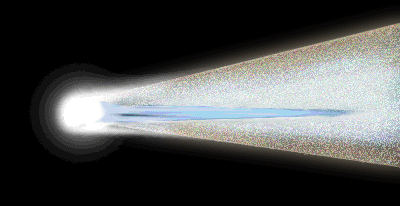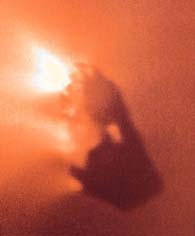 |
||
|
Part 1 Would you know a comet if you met one? |
||
 By now you know that comets are like “dirty snowballs.” The American astronomer Fred
L. Whipple proposed the "dirty snowball" hypothesis of comets
during 1950, the same year that
Oort proposed his idea of the comet cloud. Whipple realized that most of the time a comet is a small, cold, chunk of frozen gases (ices) mixed with dust grains and rocks. By now you know that comets are like “dirty snowballs.” The American astronomer Fred
L. Whipple proposed the "dirty snowball" hypothesis of comets
during 1950, the same year that
Oort proposed his idea of the comet cloud. Whipple realized that most of the time a comet is a small, cold, chunk of frozen gases (ices) mixed with dust grains and rocks. |
||
|
|
||
|
But the comets that early astronomers discovered looked like bright, blazing stars that can be seen even without a telescope. So what are we seeing when we see a bright comet with a long glowing tail? How can the "dirty snowball?" and the blazing bright objects in the gallery images be the same thing? Read on! The Coma: the comet's atmosphere The solid, snowball part of the comet is called the nucleus, which means core. If you made a comet, This is what you created: the snowball nucleus. You may have been able to see some fog coming off your comet especially if you held it up to a bright light. This fog is the dry ice vaporizing or sublimating, and the water evaporating. A few very small grains of sand or dust might have come off if you waited long enough. These changes occurred because the comet absorbed energy in the form of light and heat from its surroundings. The same thing happens when a comet comes near the Sun. As the comet approaches, it grows warmer and some of the ices heat up and become gas, releasing the dust grains that were trapped in the ice. This dusty gas coming from the nucleus is heated by the Sun and forms a glowing hot cloud around the comet called the coma. Even though the nucleus might be only a couple of kilometers across, this cloud can be up to one hundred thousand (100,000) kilometers across! That means a comet as big as a marble would have a coma as big as four-story building! So this large, glowing cloud is what appears to us as the comet's head. Seeing the Real Thing
 This is one of the pictures from Giotto. It shows the irregular nucleus of Comet Halley, and the bright flare of gases being sublimated by the Sun's light to form the coma. The orange haze all around is the glowing coma itself. This is one of the pictures from Giotto. It shows the irregular nucleus of Comet Halley, and the bright flare of gases being sublimated by the Sun's light to form the coma. The orange haze all around is the glowing coma itself.
? Comets are usually seen only in the night sky. How is it that we see the effects of the Sun's light on a comet, after the Sun has set? Hint: What makes the moon shine? Next: How the comet got its tails |
||
|
|
